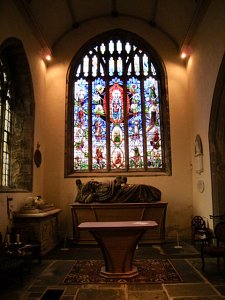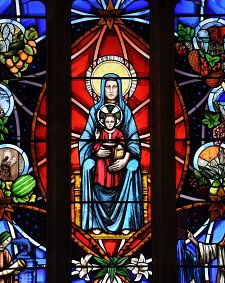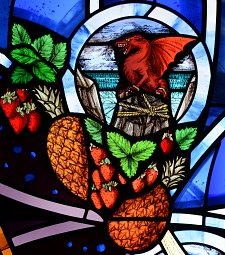THE JESSE WINDOW EXPLAINED: St Mary's Priory, Abergavenny
The Jesse Window explained
 |
 |
 |
Canon Mark Soady reflects:
"Stained glass windows came into being in Medieval times as a means of educating the largely illiterate public about the Good News of the Bible through visual images.
Helen’s window does an amazing job in encapsulating the various themes and messages that run through the Bible. It will be a great aid to teaching, and a wonderful complement to the Jesse artefact itself."
The starting point for Helen’s design is the ‘centrality of Christ as God and man’. The dual aspects of Christ are explored through images and relationships connected with the five principal themes: Christ, Kingship, Prophecy, the Church and the Sacrament.
At the top of the tree sits the Virgin Mary with the Christ child on her knee. They are shown to a larger scale then other figures in the window, recognising their great importance. Called by God to fulfil a unique and vital role, Mary becomes, by her willing acceptance, a model and guide to Christians. She is the vehicle of incarnation – and thus an essential participant in the life, death and glorious resurrection of Jesus; a connection between His earthly life and His divinity.
Beneath the Virgin sits King Solomon and below him his father David, the son of Jesse. Both Solomon and David were leaders of God’s chosen people and both point to Christ’s Kingship, yet both struggled (and at critical moments failed) to balance obedience to God’s will with the exercising of temporal power. Solomon also offers an example of Wisdom which continues with Christ. To the left of King David is his wife Bathsheba. To his right is Ruth, his great grandmother – a humble, obedient convert, she represents all outsiders who are welcomed into the wide and loving arms of the church.
Zadok the Priest and Nathan the Prophet flank Solomon. Zadok, ‘the teacher of righteousness’ reprints the continuity of priesthood and ministry, while Nathan the prophet challenged earthly power by reprimanding King David.
The figures on the extreme left and right are Adam and Abraham, representing the different but reconcilable versions of Christ’s lineage. Matthew, writing for the Jews, emphasises Christ’s coming as a fulfilment of the prophecy to Abraham. Luke, writing for the Gentiles, stresses His descent from Adam – His incarnation and pre-figuring His role as the second Adam.
Above Adam and Abraham stand the prophets Isaiah and Daniel. Isaiah foretold the coming of a ‘suffering servant’ and Daniel refused to obey the commands of an earthly power and maintained faith in God.
At the top of the outer lights stand Moses and Elijah. Moses went to a mountain and received the Commandments from God setting out the basic law of faith. In His Sermon on the Mount, Christ offers a fundamental statement of human discipleship, which will lead us to a new spiritual freedom. Elijah, who bravely challenged all false gods, appeared with Moses at Christ’s transfiguration.
In the centre of the window, surrounding the Virgin and Child, are roundels containing images representing the lives of seven significant Celtic saints, demonstrating the life of the Church in the world and grounding us firmly in our Welsh setting. They symbolise the seven Gifts of the Holy Spirit. To the left from bottom to top are Gildas (author, teacher and preacher: The Gift of Knowledge); Beuno (healer and preacher: Gift of Understanding); and Winifred (Beuno’s niece and a virgin martyr: Gift of Piety) To the right from the bottom to top are Padarn (peacemaker, pilgrim and man of forgiveness: Gift of Counsel); Non (known as the ‘Celtic sister of Bathsheba’, mother of St David – a humble parallel to the Blessed Virgin Mary: Gift of Fear of the Lord); and Teilo (founder of many monasteries and husbandman, renowned for his wisdom: The Gift of Wisdom). The Patron Saint of Wales, St David: The Gift of Fortitude is in the lower central traceries and caps the circle.
Garlanding these saintly images are fruits representing the nine attributes of the Fruit of the Spirit (Galatians 5.22): love, joy, peace, patience, kindness, goodness, faithfulness, gentleness and self-control.
The window traceries are filled with images connected to the Advent Jesse; a symbolic narrative drawn from scripture, connecting the Old Testament to the coming of Christ.
The branches of the tree are detailed as vine branches to remind us of the centrality of the Sacrament of the Holy Eucharist to our faith. On one of the branches in the bottom right is a sparrow. This is a subtle acknowledgement of Dean Jeremy Winston, in whose memory the window is erected – one of his favourite poems, A Sparrow’s Flight by Lord Hailsham, was read at his memorial service.
The window was designed by Helen Whittaker.
..
